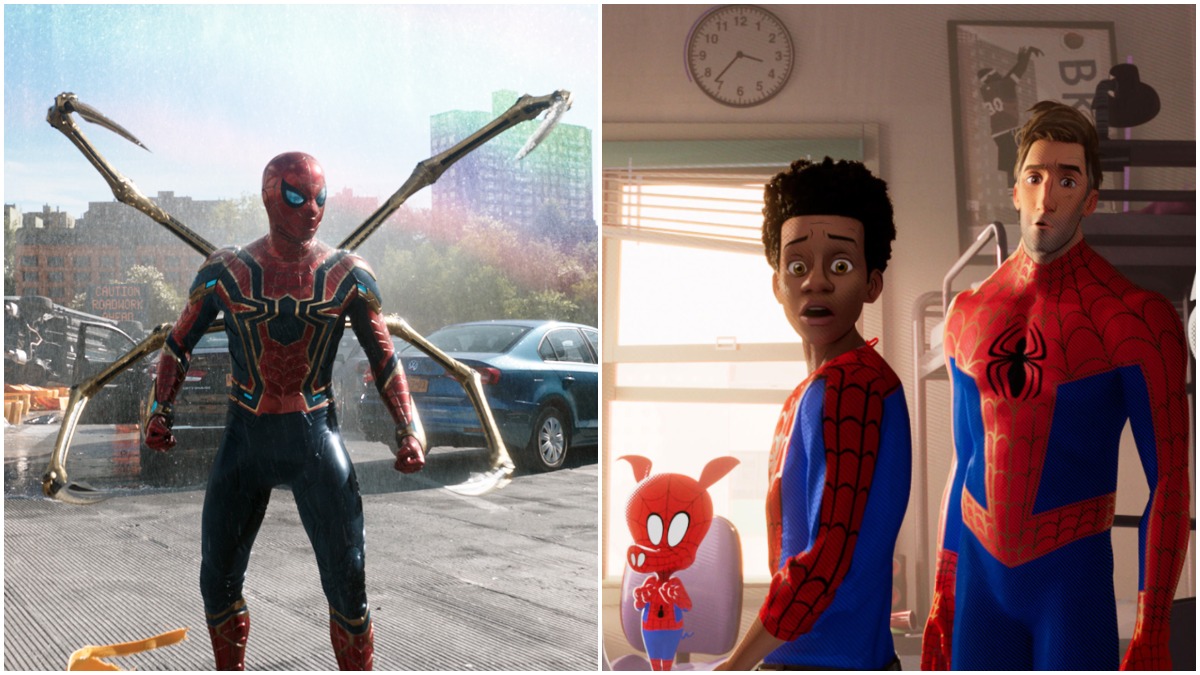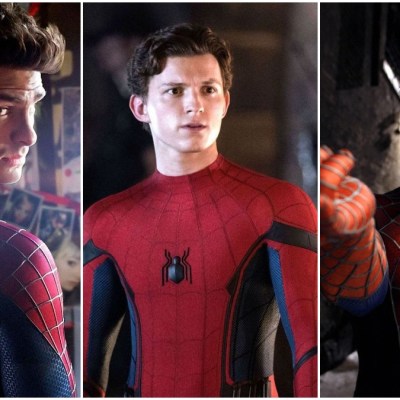This article contains Spider-Man: No Way Home and Into the Spider-Verse spoilers.
What was once just a meme has become a fact of pop culture life. Two men who would be Spidey, as originally drawn for the 1967 cartoon series, stare at each other in a back alley. Each points incredulously at the other, as if to insist that no, HE is the imposter. Two Spider-Mans, huh? Things really were simpler back in the ‘60s!
These days, it seems you can’t make a wallcrawler movie without at least three Web-Heads swinging around. We’re sure Sony Pictures accountants will suggest as much after the final tally from this weekend’s box office smash, Spider-Man: No Way Home, is counted.
In the new film, we don’t just get to follow the adventures of Tom Holland’s beloved Peter Parker after Spider-Man: Far From Home’s cliffhanger. In fact, that cliffhanger is almost moot since the weekend release also features the return of nostalgic favorites like Tobey Maguire’s Pete, who’s likewise brought along with him some of the fan fave villains of his era, including Alfred Molina’s Doc Ock and Willem Dafoe’s Green Goblin. Additionally, The Amazing Spider-Man era is tapped with Andrew Garfield’s moody Parker and a couple of his rogues also appearing for an encore.
For many fans it was a surreal dream come true seeing three different eras of Spider-Man actors on-screen at the same time. But then again, the path was already laid for Marvel Studios several years before when the even more wild Spider-Man: Into the Spider-Verse released in December 2018 to rave reviews and, miraculously, enough goodwill to propel the flick to a Best Animated Feature Oscar—upsetting a category typically dominated by Disney Animation or Pixar Studios.
Both recent Spidey joints, one live-action and the other animated, feature a cornucopia of webslingers and supervillains, dead relatives and hardwon lessons. Yet which did the whole Spider-Verse thing better? Well, to put our cards on the table right at the top, it’s Spider-Man: Into the Spider-Verse by a country mile. But if you would let us explain why, please read on…
The Appeal of Doing a Spider-Verse Movie
Both Spider-Man: Into the Spider-Verse and Spider-Man: No Way Home attempt the concept of a “Spider-Verse” movie for obvious reasons: Having multiple Spider-Mans on-screen is totally rad.
And yet, both are attempting to accomplish different things by going the Spider-Verse route. While originally conceived in 2014 as a way to merge the various Spider-Man comic book mythologies into one yarn (although that, in turn, was inspired by the series finale of the 1990s’ Spider-Man: The Animated Series), the idea of a “Spider-Verse” has been treated by filmmakers largely as a jumping off point instead of a single story worth adapting.
No Way Home is probably closer in spirit to the comic books’ approach of the Spider-Verse, which on the page was used to merge the events of traditional Marvel Comics (or the “Earth-616”) and the Ultimate Comics’ popular creation of Miles Morales under the same proverbial inter-dimensional umbrella. Miles, of course, doesn’t appear in No Way Home. But merging various fan favorite versions of the Spider-Man character into one adventure appears to be Marvel Studios’ driving motivation.
Thus the plot in No Way Home ultimately functions as a narrative vehicle to get to the fan-pleasing moment of seeing Tobey Maguire, Andrew Garfield, and Tom Holland all on-screen at the same time. Hell, they even mimic the Spider-Man pointing meme from the ’67 cartoon.
Conversely, Into the Spider-Verse uses the concept less as an excuse to push its audiences’ nostalgia buttons and more as an opportunity to get weird. This is intended to be a meta-textual celebration of why the character is so beloved, and the party rages at both a macro level where various versions of Spider-Man can comment on the recurring, foundational themes (or tropes) of their personalities, as well as at an intimate scale where new characters can catch audiences by surprise.
This includes the lead protagonist of Miles Morales, wonderfully voiced by Shameik Moore. A popular creation among comic fans, Miles seemed immediately destined for the big screen treatment after he was introduced in 2011. Nevertheless, the character was still a pretty big surprise to general film audiences in 2018 if their only point of reference for the webslinger is Maguire, Garfield, and Holland. Hence why Into the Spider-Verse works so hard to make you fall in love with Miles for almost half an hour, well before he really gets to use his spider power. It succeeds beautifully.
Even so, directors Bob Persichetti, Peter Ramsey, and Rodney Rothman, plus screenwriters Rothman and Phil Lord, refuse to use the Spider-Verse only as a means to introducing the general audiences to Miles. Rather we are likewise introduced to a dizzying array of variances and bizarre flourishes that have been implemented over the decades by comic book artists (and filmmakers) in order to re-contextualize this character. That ranges from a noir superhero fighting Nazi saboteurs in the 1930s to a literal talking Porky Pig styled cartoon.
Spider-Man: Into the Spider-Verse plays with your nostalgia by mimicking literal moments from the Sam Raimi directed Spider-Man trilogy—we see a Spidey kiss Mary Jane upside down in the rain (and in another universe vice versa), a la Maguire’s first movie, and we see the same Spidey stop a runaway train like the showcase sequence in Spider-Man 2. Producers Lord and Chris Miller even initially mused that one of the Peter Parkers whom Miles looks up to could be Maguire’s Parker all grown up and middle aged.
However, they eventually went a different direction because the point wasn’t just to show you something you’ve seen, but to show you something so different that when it did feel familiar, it reveals the elemental values of the character on a fundamental level. In this way, it would expose the quintessence of Spider-Man, as opposed to just make you happy to see an old favorite actor go THWIPP! one last time.
Why the Adventure Matters to Our Spider-Man
Both films also attempt to take their hero on a transformational journey. Although in one case, the Spider-Verse is the pivotal turning point in the road for the movie’s plot—and in the other, it’s almost a detour.
Spider-Man: Into the Spider-Verse is at its heart a cinematic origin story for Miles Morales. Like the Ultimate Spider-Man comics line, it’s about a young biracial child growing up in modern day Brooklyn. His ascendence into adolescent self-discovery is a classic convention of literature—and in Spider-Man movies after Maguire and Garfield also started their tenures with origin movies—but it’s told from a distinctly different point-of-view.
Credit should be given to the filmmakers of Spider-Verse, too, that Miles’ world feels so different from the more timeless movie nerd backstory most famously given life by Maguire’s Spider-Man debut. Nonetheless, it is the Spider-Verse itself which allows Miles and his world to stand apart from previous Spidey movies. Discovering there are countless other versions of Spidey out there creates both an inspirational legacy and an intimidating obstacle he will spend the whole film overcoming. When he does, he becomes his own man.
No Way Home, by contrast, is ostensibly the story of Holland’s Peter Parker dealing with the fallout of the world discovering he’s Spider-Man. Suddenly, a character who prized his anonymity is a celebrity, shattering his everyman normalcy and eventually his life as it attracts fiends who wind up killing his beloved Aunt May (Marisa Tomei). Be that as it may, the Spider-Verse is less crucial to his learning to live with the consequences of his actions than it is a sideshow attraction which overtakes the main plot.
Read more
Indeed, Holland has previously said that until No Way Home became a Spider-Verse movie, there were discussions about making it about Peter versus Kraven the Hunter. One imagines fragments of that treatment exist in the first act of the finished picture, where federal authorities threaten to charge Peter Parker with murder and illegal vigilantism while his high school daily life is shattered. He even needs to hire a lawyer in the guise of Matt Murdock.
Unfortunately, these narrative threads are almost entirely abandoned by the time Molina’s Doctor Octopus rises from the grave and turns the movie into something else. Before that moment, one might wonder how Peter is avoiding jail time—a fact that’s mostly ignored in the rush to get to Doctor Strange during the movie’s first act. I certainly would’ve liked to know how his high school life continued beyond that awkward first walk through the halls. But there’s no time to explore the personal cost of Peter’s exposure beyond the broad strokes of him and his friends not getting into MIT. The movie simply doesn’t have time when it needs to reintroduce us to a slew of familiar faces.
While I smiled ear to ear at seeing Doc Ock again, and I laughed with everyone else in the audience as Garfield and Maguire perfected their buddy Spidey routine and one massaged the other’s bad back, I’m not sure how much their inclusion affected our main Peter’s story. Doc Ock’s inclusion, frankly, felt more important to Maguire who gets to share a moment where the two meet like old friends and as equals, instead of enemies or as a mentor and his prospective protege. But for Holland? It leaves him mostly in the weeds beyond dealing with the consequences of Norman Osborn killing Aunt May—and one didn’t need the multiverse for that to happen.
The Use of the Other Spider-Men and Women
Perhaps the most striking thing though is the missed opportunity in No Way Home to really contrast the differences between the three Peter Parkers, which would make their similarities all the more winning. Since the reveal of Maguire and Garfield’s Parkers is saved as a reward for making it to the third act, neither is in the movie long enough to truly be a mentor for Holland’s Peter or be fully explored themselves. Rather they exist to nerd out about all the stuff we already know regarding each of them—this one’s got organic webshooters, that one fought a mechanical Rhinoceros, and our guy over here got to go to space! Did someone mention Gwen Stacy dying yet?
The most telling aspect in this regard is how little we learn about what Maguire’s Spidey has been up to in the last 14 years beyond “trying to do better”—which is itself a callback to a line of dialogue he said in 2004. Each one of these Spideys are at different stages of their life: middle age, mid-30s, and a teenager. What lessons can one generation teach the other? It’s vague since all we really know is that things are still “complicated” between Maguire’s Peter and Dunst’s Mary Jane nearly 20 years since they first kissed in 2002. Keep in mind that’s the same way Peter described his relationship with her to Otto Octavius in 2004.
Granted, the way the movie was constructed didn’t really leave time to develop what this version of Peter has been up to in the intervening decades. But that’s the point. He exists in the movie almost entirely to service the fans with winning helpings of nostalgia and then go on his merry way. And since we don’t have time to see how he ended up like this, let’s just remind you of his and MJ’s ongoing soap opera—promising it’s exactly as you remember it, even though they’re now in their 40s.
Really?
Now compare this with the brilliant contrast between a sadder and wiser Peter Parker from another dimension (voiced hilariously by Jake Johnson) and Miles in Spider-Man: Into the Spider-Verse. Their relationship is the backbone of the animated film, establishing a buddy routine that is developed further than the gag of them getting their names confused.
Unlike the Peters in No Way Home (or perhaps some comic versions), Johnson’s Parker has no initial interest in mentoring Miles. He’s been there, done that and has saved the world so many times that he’s become jaded. He even has a snarky name for the MacGuffins that these end-of-existence plots revolve around (particularly in MCU movies): a Goober.
It’s a more cynical Peter, but one that has enough distance to add a different flavor—in this case, mildly self-aware bemusement about the plot contrivances of the adventures which comprise his life. It’s a different perspective.
Here was a Peter who experienced something approximating what Maguire’s Parker went through in his late teens and early 20s, but now we get to revisit him decades later and see where this lifestyle took him. It’s left him jaded, yes, but also lonely and despairing. After seeing so much evil in the world, he decided he didn’t want to have kids. MJ, meanwhile, married him years and years ago, and has now grown apart due to her desire for children. The pair are close to losing everything because of adult problems and not because some lunatic is trying to drop her from a great height.
What the superhero lifestyle does to the everyman is explored by Johnson’s Peter, as well as the alternative presented by the golden boy version briefly voiced by Chris Pine. Each has life lessons to impart to Miles that also emphasize his youth since the domestic problems of their adult lives seem eons away from a kid who is scared to talk to Gwen Stacy (Hailee Steinfled).
Oh, and speaking of Gwen, she’s here too as Spider-Gwen. Yep, Into the Spider-Verse ventures past the safety of rose tinted nostalgia to promise there are so many things left to do with the Spidey character than what we’ve previously watched. And Steinfeld’s Spider-Gwen has proven almost as popular as Moore’s Miles, bringing a spunky cool streak and punk vibe to a franchise that has mostly leaned on the tropes associated with well-meaning nerds. And her flirtatious relationship with Miles provides further insight into a different side of Miles in the same way his relationship with Peter B. Parker illuminates his youthful inexperience and naivety.
We see glimpses of the daily lives of each of these characters, Peter B., Spider-Gwen, and even Spider-Man Noir, and in turn we have a stronger idea of what makes Spider-Man, well, Spider-Man.
Putting on a Friendly Neighborhood Show
Of course no movie is purely about narrative structure and character arcs. Cinema is a visual medium, and when it comes to dynamic, visceral storytelling there is little competition between the movies.
Spider-Man: Into the Spider-Verse is one of the most dazzling computer-generated animated films ever produced by a major Hollywood studio. In an moment where Hollywood animation risks driving closer to a hegemonic sameness that favors photorealistic backgrounds with elaborately cartoonish central characters, Into the Spider-Verse feels like a breath of fresh air with art styles that blend modern street art, classic comic book Ben-Day dots imagery, and even eccentric oddball flourishes of Japanese anime and black and white cel-shading (depending on the character).
The shot where Miles falls upward, with the digital “camera” inverted so when he plunges heroically toward the earth he’s visually ascending to the heavens with maximum self-esteem, is as cinematic an image as ever produced by a Spidey movie.
It’s a showcase for the limitless potential of digital animation when it’s allowed to draw outside the proverbial lines. Meanwhile No Way Home looks like almost any other MCU movie. It’s a picture with a flat, bordering on gray TV-esque color palette that favors familiarity and character iconography over having a strong sense of cinematographic identity. Also, personally, too many blue screens are employed to hide the fact that this was mostly shot in soundstages in Atlanta instead of on the streets and highways of New York City.
So, yes, from most angles Into the Spider-Verse is a far greater triumph of style and substance in this writer’s opinion, but I still enjoy No Way Home in the way it was intended: as a fond love letter to previous movies that were once so dear. Nostalgia is pleasant, but Into the Spider-Verse presents its own thrilling vision that one day we can be wistful about on its own.


